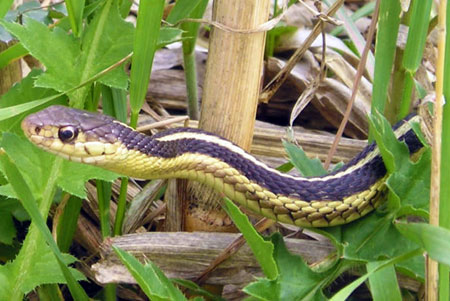Snakes and your garden
If it slithers is it welcome?
Many gardeners really enjoy being outside and caring for their landscapes. But a certain percentage is very concerned about snakes also enjoying that same landscape. The question which gets asked of Michigan State University Extension Horticulture Educators and Hotline Master Gardeners is, “How can I make snakes stay away from my garden?”
There is no magic spray or product that guarantees that snakes will respect your property lines. Some of the snake repellants are just a version of moth balls. They may not be effective and evaporate rapidly in the open air. But what’s a “snake-o-phobe” supposed to do?
There are several ideas that can be culled from old MSU Extension publications. All work on the principal of changing the habitat so it less inviting for snakes to visit. This involves removing hiding places. Getting rid of rock and brush piles not only discourages snakes, but keeps some of the critters, like various rodents, from having a hiding place. This includes any material like old lumber or firewood that provides hiding places. Snakes appreciate the ability to warm themselves on rocks or pieces of cement early in the spring when the weather is not very warm. Some snakes feed on rodents while other feed on earthworms, slugs, toads, salamanders, frogs, insect larvae, spiders, small mammals and birds.

Garter snake. Photo credit: Blaine Hansel, Wikimedia Commons
Keeping grass mowed regularly also removes places for snakes to patrol for food. Keep in mind that various feathered predators are also patrolling the skies, hoping for a tasty snake snack. Trimming up bushes and shrubs so they do not touch the ground eliminates more hiding places.
Snakes, being relatively defenseless, look for places to hide in and around the foundation of the house. Close openings around porches and steps. Make sure that the area where the foundation and the siding meet is secure. This not only shuts out snakes, but rodents that would love to drop by for tea. If there are openings under decks, various critters can hide there in relative anonymity. This includes woodchucks, skunks and the ever-popular raccoon. Just say no to all of them by blocking access.
While outside gardening, consider taking a long-handled gardening tool like a hoe or rake or a lightweight walking stick along. You can literally “beat the bushes” to disturb anything in the area where you are going to walk or work. It should not be violent enough to damage the plants, but just offer a wakeup call for any dawdlers.
Some of the purchased snake repellants contain a product like mothballs or paradichlorobenzene. These volatilize into the air rapidly and may not last a long time. Others have ingredients like cinnamon, peppermint and clove oils in the products. But smart gardeners know that the best long term solution is habitat modification.
To learn more about snakes, “Michigan Snakes, a Field Guide and Pocket Reference” by J. Alan Holman and James H. Harding (E-2000) is available for sale from the Michigan State University Bookstore.



 Print
Print Email
Email

